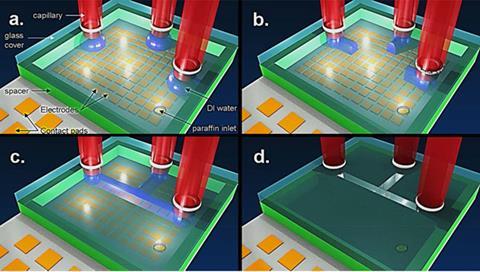A microfluidic chip with channels that can be programmed then reset and reconfigured has been developed by scientists from France and Japan.
In recent years, scientists from across of the globe have developed a plethora of microfluidic chips to perform a variety of tasks, from PCR to cell sorting. However, a serious drawback of microfluidic technologies is that each application requires a unique arrangement of inlets, outlets and microchannels, so microfluidic chips are usually specific to one particular purpose. This, combined with the time-consuming and costly manufacturing processes required to construct microfluidic devices, makes the idea of a reprogrammable chip very attractive.
The chip developed by Rapha?l Renaudot from CEA-Leti and coworkers consists of a bottom support, which contains an array of electrodes, and a top plate made of glass, with paraffin wax and distilled water sandwiched in between. At 45 °C, the paraffin wax is liquid. By selectively switching on particular electrodes, the water in the chip can be manipulated into defined shapes via a process known as electrowetting. If the temperature is then dropped to below ¬40 °C, the paraffin wax freezes and the shape that was carved out by the water becomes fixed in the structure. Using this technique, the team were able to draw different microchannel geometries into the chip.
If you increase the temperature back up to around 40 °C, the paraffin wax melts and you can start all over again. In this respect, the chip can be likened to an Etch A Sketch – you can program in the configuration of microchannels that you want, raise the temperature to reset the chip and then program in a different configuration of microchannels. As a result, this single chip could be used for a variety of applications.

Experts in microfluidics have praised the innovative chip design. Hyejin Moon from the University of Texas at Arlington in the US describes the work as groundbreaking and expects that ‘it will stimulate research on other phase changing materials’. Hywel Morgan from the University of Southampton in the UK agrees that the work is interesting but thinks that there are improvements to be made. ‘Increasing the resolution of the device with much smaller electrodes should lead to a significant improvement in channel resolution, which is important if these structures are to find a place in microfluidic systems,’ says Morgan.
Indeed, Renaudot and colleagues are now working to improve their chip by testing alternative materials to paraffin wax.






No comments yet